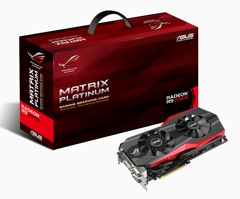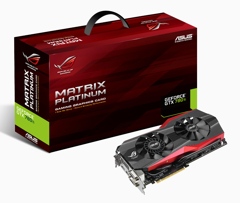
ASUS ha annunciato due nuove video card hign-end nell'ambito della linea ROG Matrix concepita notoriamente per i gamer e gli overclocker. Più in dettaglio, il board maker taiwanese ha introdotto le soluzioni siglate ROG Matrix R9 290X e ROG Matrix GTX 780 Ti, attraverso le quali sono estremizzate le potenzialità delle gpu AMD Radeon R9 290X e NVIDIA GeForce GTX 780 Ti rispettivamente.
Entrambe le schede video sono state progettate per offrire prestazioni al top della categoria in ambito overclocking: a tal fine ASUS ha dotato i nuovi prodotti di uno stadio di alimentazione e di un sistema di raffreddamento ampiamente potenziati rispetto a quelli previsti dal design reference.
Lo stadio di alimentazione di entrambe è basato su un VRM a 14 fasi, implementato in accordo alla tecnologia proprietaria DIGI+, e include esclusivamente componenti discreti, come i MOSFET, i condensatori e gli induttori, di elevata qualità.
Il cooler delle card abbina le caratteristiche tipiche della tecnologia DirectCU, a partire dalla dotazione di heat pipe in rame da 10mm posizionate a diretto contatto con la gpu, a quelle della tecnologia CoolTech, che assicura invece la realizzazione di ventole tanto efficienti nell'innescare i flussi d'aria quanto in grado di minimizzare il livello di rumore.
Il core grafico della gpu della ROG Matrix R9 290X lavora a fino a 1050MHz in termini di valore massimo della frequenza di boost (il corrispondente valore reference è inferiore di circa 50MHz), mentre il frame buffer (4GB di RAM G-DDR5) a 5400MHz. Lo scambio dei dati tra il processore grafico e la memoria locale avviene mediante un bus a 512-bit mentre il kit di connettori di uscita è composto da una porta HDMI, una DisplayPort e due DVI-D.
Il core grafico della gpu della ROG Matrix GTX 780 Ti opera con una frequenza di boost il cui valore massimo, superiore di 144MHz riaspetto al corrispondente valore reference, è pari a 1072MHz. Il frame buffer è realizzato con 3GB di RAM G-DDR5 e lavora a 7000MHz, mentre l'interfaccia tra la gpu e la memoria on board è a 384-bit. I connettori di uscita di questa card sono i seguenti: due DVI-D, uno HDMI e uno DisplayPort.
ROG Matrix R9 290X

[Immagine ad alta risoluzione]
ROG Matrix GTX 780 Ti

[Immagine ad alta risoluzione]

ASUS Republic of Gamers (ROG) today announced Matrix R9 290X and Matrix GTX 780 Ti, two new graphics cards that squeeze breathtaking performance from the latest R9 290X and GeForce GTX 780 Ti graphics-processing units (GPUs).
ROG Matrix R9 290X and GTX 780 Ti build on the renowned and highly-trusted ROG Matrix legacy as the coolest, quietest and most-readily-overclocked graphics cards available. DirectCU II cooling and CoolTech fan technologies combine with the brand-new Memory Defroster feature to create the perfect balance between spectacular power and out-of-the-box simplicity - all dressed up in the seductive ROG wardrobe.
With support for next-generation 4K/UHD (ultra-high-definition) gaming resolutions of up to 4096 x 2160 pixels, Matrix R9 290X and GTX 780 Ti deliver incredible gaming experiences today and far into the future.
Hand-picked quality for breathtaking performance
Both ROG Matrix R9 290X and GTX 780 Ti benefit from hand-chosen cores to deliver clock speeds that are streets ahead. Respectively, the cards speeds along at 1050 MHz and 1072 MHz (boosted) - that's an incredible 50 MHz and 144 MHz faster than reference designs.
For serious games-players this means a significant performance boost of up to 13% for super-smooth frame rates that refuse to stutter. With up to 4 GB of high-speed DDR5 video memory on board, Matrix R9 290X and GTX 780 Ti enable gamers to enjoy very high resolutions and detail levels.
Engineered for extreme, user-friendly tuning and overclocking
The new ROG Matrix series cards are brimming with advanced and exclusive hardware and software features designed to make overclocking as simple and safe as possible.
Memory Defroster is a brand-new feature that's designed to excite extreme overclockers. This clever technology quickly defrosts the graphics card's memory during below-zero overclocking to ensure sustained stability. Extreme overclockers will also appreciate the Matrix series' liquid-nitrogen (LN2) jumper switch, as it enables even more overvolting options - allowing the most adventurous users to unleash maximum greater power from their graphics cards.
The ROG Matrix series' Safe Mode allows users to overclock with complete confidence, as a single button push will restore default BIOS settings instantly.
To support stable overclocking, the ROG Matrix cards are also equipped with exclusive DIGI+ voltage-regulator modules (VRMs) with Super Alloy Power technology. The DIGI+ VRM delivers 14-phase power and digital voltage regulation, while Super Alloy Power's Japanese-made 10k black-metallic capacitors, 14 ultra-high-amperage full-molded chokes and extremely-efficient MOSFETs all withstand much greater stress and heat due to the application of specially-formulated materials.
The combination DIGI+ VRM and super-strength Super Alloy Power components mean that Matrix R9 290X and GTX 780 Ti are forged for high-load performance and extreme overclocking without annoying whines and buzzes noises - so hardcore overclockers can enjoy plenty of headroom for experimental performance tuning without creating gameplay distractions.
Coolest of the cool and finished with renowned ROG panache
ROG Matrix R9 290X and GTX 780 Ti stay ultra-cool at all times, thanks some highly advanced and unique technologies - DirectCU II and CoolTech fan technology.
DirectCU is an innovative thermal technology that's exclusive to ASUS. It puts highly-conductive 10 mm copper cooling pipes in direct contact with a card's GPU, so heat is dissipated quickly and with extreme efficiency. As well, the new ROG Matrix series introduces a new heat-sink that's finished in a stunning matt black, so the cards look as great as they're kept cool.
The ROG Matrix cards also feature CoolTech fan technology. The CoolTech fan employs a hybrid blade and bearing design, with inner radial blower and outer flower-type blades to provide multi-directional airflow that accelerates heat removal to ensure high-end graphics performance that's highly stable. The fan's ramp is carefully tuned to ensure minimal noise.
For a final dash of style that's loaded with substance, ROG Matrix even features a gorgeous color-coded LED: this shines brightly and changes shade to reflect the GPU's load level, providing a useful visual guide for both casual and hardcore gamers.
Safe and intuitive software overclocking and sharing with GPU Tweak
The new ROG Matrix cards include GPU Tweak, an easy-to-use utility that gives users intuitive control over GPU and video-memory clock speeds and voltages, cooling-fan speeds and power-consumption thresholds, so they can overclock easily and with high confidence.
The exclusive ROG edition of GPU Tweak adds detailed GPU load-line calibration and VRM-frequency tuning, allowing incredibly fine control over multiple parameters for maximum overclocking and the potential to break world records.
As well, the GPU Tweak Streaming tool lets users share on-screen action over the internet in real time - so others can watch live as games are played. It's even possible to add a title to the streaming window along with scrolling text, pictures and webcam images.
AVAILABILITY & PRICING
ROG Matrix R9 290X and Matrix GTX 780 Ti will be available worldwide from March 2014.
ROG Matrix R9 290X - AMD Radeon R9 290X
- PCI Express 3.0
- OpenGL 4.4
- 4096 MB (4 GB) GDDR5 memory
- 1050 MHz engine clock speed
- 5400 MHz (1350 MHz GDDR5) memory clock
- 512-bit memory interface
- 4096 x 2160 maximum resolution
- 2 x DVI-D output
- 1 x HDMI output
- 1 x DisplayPort output
- HDCP-compliant
- ASUS GPU Tweak and drivers included
ROG Matrix GTX 780 Ti- NIVIDA GeForce GTX 780 Ti
- PCI Express 3.0
- OpenGL 4.4
- 3072 MB (3 GB) GDDR5 memory
- 1072 MHz boost clock
- 7000 MHz memory clock
- 384-bit memory interface
- 4096 x 2160 maximum resolution
- 1 x DVI-D output
- 1 x DVI-I output
- 1 x HDMI output
- 1 x DisplayPort output
- HDCP-compliant
- ASUS GPU Tweak and drivers included
News Source: ASUS Press Release
Links
|